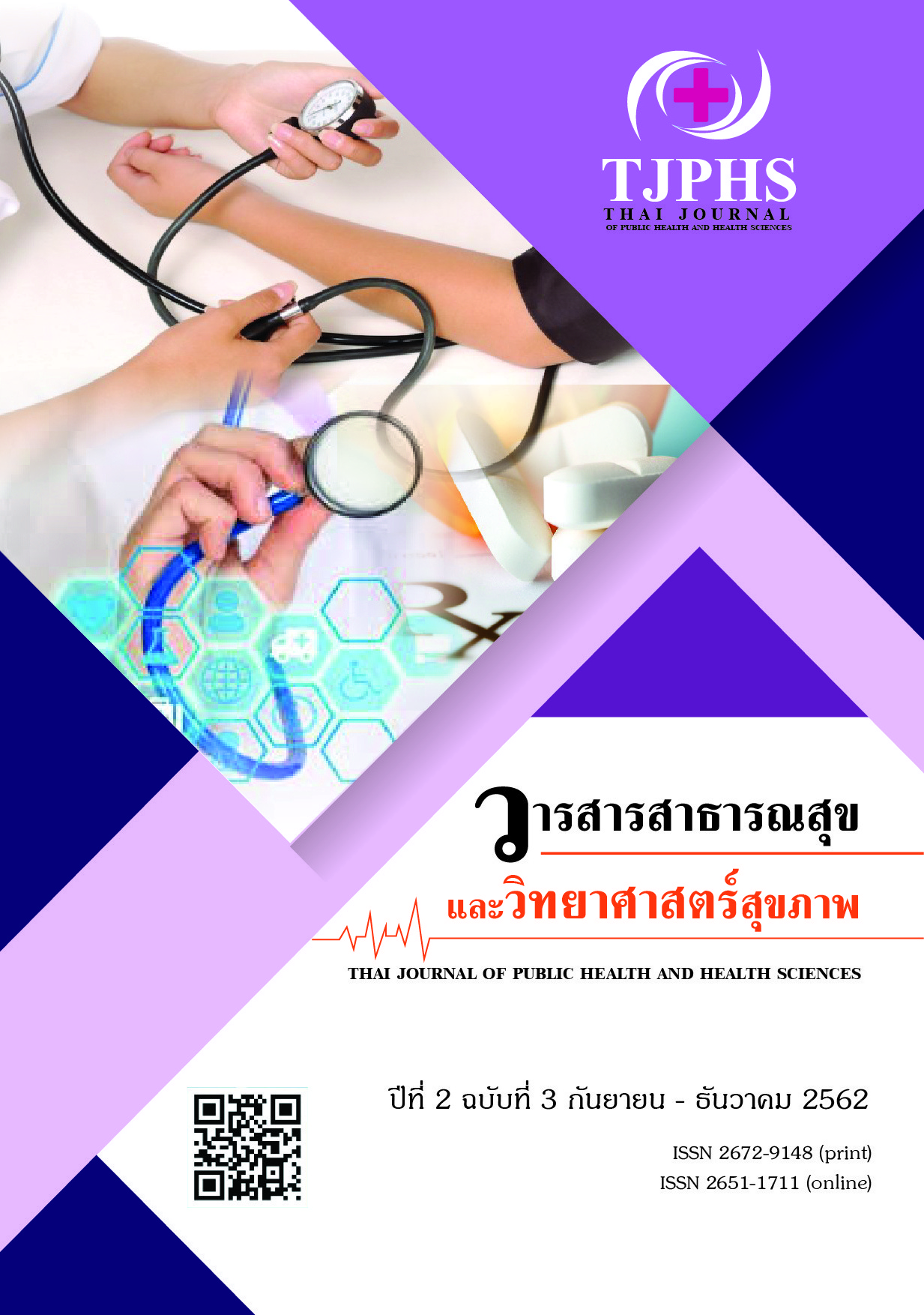พฤติกรรมการดูแลเท้าของผู้ป่วยเบาหวานชนิดที่ 2 ในคลินิกเบาหวาน โรงพยาบาลสิงหนคร อำเภอสิงหนคร จังหวัดสงขลา
คำสำคัญ:
พฤติกรรมการดูแลเท้า, ผู้ป่วยเบาหวานชนิดที่ 2, ระดับ HbA1C.บทคัดย่อ
การวิจัยเชิงพรรณนานี้ มีวัตถุประสงค์เพื่อศึกษาระดับของพฤติกรรมการดูแลเท้า และเพื่อเปรียบเทียบพฤติกรรมการดูแลเท้าของผู้ป่วยเบาหวานชนิดที่ 2 จำแนกตาม ปัจจัยด้านบุคคล ปัจจัยด้านการป่วยเป็นโรคเบาหวาน และปัจจัยด้านสภาพเท้า กลุ่มตัวอย่างคือกลุ่มผู้ป่วยเบาหวานที่ได้รับการวินิจฉัยว่าเป็นโรคเบาหวานชนิดที่ 2 ตั้งแต่ 1 ปี ขึ้นไป ที่มารับบริการตรวจรักษาที่คลินิกเบาหวาน โรงพยาบาลสิงหนคร จังหวัดสงขลา คำนวณกลุ่มตัวอย่างโดยใช้โปรแกรม G*Power จำนวนทั้งหมด 159 คน สุ่มตัวอย่าง โดยวิธีหยิบฉลากแบบไม่คืนที่ เครื่องมือที่ใช้ คือ แบบสอบถามปัจจัยด้านการป่วยเป็นโรคเบาหวาน แบบสอบถามปัจจัยด้านสภาพเท้า และแบบสอบถามพฤติกรรมการดูแลเท้า รวมทั้งสิ้น 34 ข้อ ได้ค่า IOC ระหว่าง 0.67 – 1.00 ค่าสัมประสิทธิ์แอลฟ่าของครอนบาค ทั้งฉบับเท่ากับ 0.778 วิเคราะห์ข้อมูล โดยใช้ ร้อยละ ค่าเฉลี่ย ค่าความเบี่ยงเบนมาตรฐาน ค่าต่ำสุด ค่าสูงสุด และสถิติ Independent t –test
ผลการวิจัยพบว่า พฤติกรรมการดูแลเท้าของผู้ป่วยเบาหวานชนิดที่ 2 ในภาพรวมอยู่ในระดับสูง ( = 2.18, SD = 0.39) ผู้ป่วยเบาหวานที่มีเพศและการสูบบุหรี่ต่างกัน มีพฤติกรรมการดูแลเท้าแตกต่างกันอย่างมีนัยสำคัญทางสถิติที่ระดับ 0.001 ส่วนผู้ที่มี HbA1C และระดับความรู้สึกสัมผัสเท้าต่างกัน มีพฤติกรรมการดูแลเท้าไม่แตกต่างกัน ดังนั้น ควรจัดให้มีเวทีแลกเปลี่ยนเรียนรู้ มีการให้ความรู้แก่ผู้ดูแลเพื่อให้มีส่วนร่วมในการดูแลผู้ป่วยร่วมกับเจ้าหน้าที่
เอกสารอ้างอิง
risk factors among patients with diabetes in Bahrain: a nationwide primary care diabetes clinic-based study. Jurnals of
Saudi Medicine, 27(1), 25-31
Al - Maskari, F., El-Sadig, M. (2007). Prevalence of risk factors diabetic foot complications. BMC Family Practice.
Retrieved April 22, 2013, from http://www.biomedcentral.com.
Budsakkaew, W. (2012). The Outcomes of Empowerment Program in Diabetic Patients at the Tertiary Level Hospital in
Petchaburi Province. Graduate School of Christian University.
Chuepa, S. (2016). Impact of an Integrative Podiatric Care Programme on Foot-Care Behaviour, Foot Conditions and
the HbA1c Level in Diabetes Patients with High Susceptibility to Foot Wounds. Thai Journal of Nursing Council, 31(1):
111 – 123. (In Thai)
Desalu, O. , Salawu, F. K., Jimoh, A. K., Adekoya, A. O., Busari, O. A. & Olokoba, A. B . (2012). Diabetic foot care : self
reported knowledge and practice among Patients attending Three tertiary hospital in Nigeria. Department of Medicine,
University of llorin Teaching, Nigeria.
Jun-In, N., Siripitayakunkit, A., and Malathum, P. (2015). Foot Care Behaviors of Older Persons with Type 2
Diabetes. Rama Nursing Journal, 21(2): 199 – 213.
International Diabetes federation. (2558). Campaign issues World Diabetes Day 2014 (Fiscal Year 2015). (In Thai)
Namvongprom, A. and Pakdevong, N. (2010). Foot Ulcers and Factors Relating to Foot Ulcers in Persons with Type 2
Diabetes. Thai Journal of Nursing Council. 25(3): 51 – 63. 2559. (In Thai)
Orem, Dorothea E. (2011). The Self-Care Deficit Nursing Theory. (Online).
http://nursingtheories.weebly.com/dorothea-e-orem.html. (Access Date: May 3, 2013).
Phormpayak, D., Ajchariyasakchai, M., and Pamtaisong, S. (2017). Factors Relating to Foot Ulcers in Persons with
Type 2 Diabetes. Journal of Health Science, 26(2): 353 – 361. (In Thai)
Singhanakhon Hospital. (2016). HT/DM Database (Fiscal Year 2017). (In Thai)
Srimaksuk, K. (2014). The Outcomes of the Utilization of Clinical Nursing Practice Guidelines in Prevention of Foot
Ulcer amongst Diabetic Type II Patients. KKU Research Journal, 6(1): 150-161. (In Thai)
Songkhla Provincial Public Health Office. (2016). Chronic Disease Surveillance Report (Fiscal Year 2017). (In Thai)
ดาวน์โหลด
เผยแพร่แล้ว
รูปแบบการอ้างอิง
ฉบับ
ประเภทบทความ
สัญญาอนุญาต
บทความทุกบทความที่ได้รับการตีพิมพ์ถือเป็นลิขสิทธิ์ของ วารสารสาธารณสุข
















